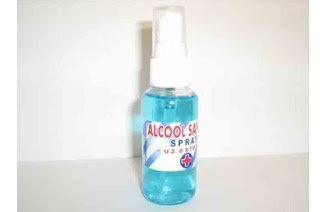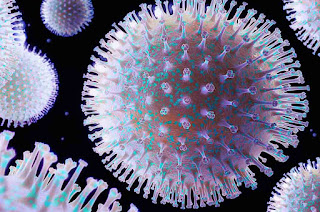 |
| Image From: image.ec21.com |
Advantages and disadvantages of some Antiseptic - The election form or type a good antiseptic is the main thing in making purchases in stores of chemicals in particular chemicals categories include technical or commonly referred to as an antiseptic. and here is an antiseptic, advantages and disadvantages as follows:
Alcohol
Benefits of alcohol for health, Ethyl and isopropyl alcohol 60-90% is good and chemicals are easily obtained and inexpensive. It is very effective in reducing microorganisms on the skin.
Also effective against viral hepatitis and HIV, do not used for mucous membrane (e.g. in the vagina), because alcohol dry out and irritate the mucous membranes and then stimulates the growth of microorganisms.
According to Larson (1995) alcohol is one of the safest antiseptic. Ethyl or isopropylalcohol 60-70% effective and less skin drying at higher concentrations, cheaper thanthe higher concentration. Due to the drying of the skin less, ethyl alcohol is more often used on the skin.
1. Benefits of alcohol:
Quick kill fungi and bacteria including mikrobakteri; isopropyl alcohol kill most viruses, including HIV and HBV; ethyl alcohol kill all types of viruses.
Although alcohol does not have the effect of killing persistent, rapid reduction of microorganisms on the skin, protects the organisms grow back even under the glove for a few hours.
Relatively cheap and available everywhere.
Relatively cheap and available everywhere.
2. Disadvantages of alcohol:
- Need emulien (for example Glycerin or propylene glycol) in order to prevent dryingof the skin.
- Easy drying of the skin.
- Easily inactivated by organic material.
- Flammable so need to be stored in a cool place or well ventilated.
- Damage the rubber or LaTeX.
- Cannot be used as a cleaning material. (Syaifudin, 2005)
 |
| Image From: netdoctor.cdnds.net |
Klorheksidin Gluconate (CHG)
Klorheksidin gluconate is an excellent antiseptic. He remained active against microorganisms in the skin a few hours after the giving and safe even for infants and children.
Because klorheksidin gluconate inactivated by SOAP, residual activity is dependent on its concentration. The concentration of 2-4% is recommended. The new formulation in water 2% and 1% klorheksidin without water, mixed alcohols are also effective.
1. Gain:
- Broad spectrum antimicrobial.
- Chemically active for at least 6 hours.
- Chemical protection (the number of microorganisms hindered) increases with the use of re.
- Influence of organic material is minimal.
- Available commercial products, that public is mixed with detergent and alcohol.
2. Loss:
- Expensive and not always available.
- The effect of reduced or dinetrelisasi by SOAP, running water, and some hand cream.
- Not effective against TB bacilli, good and effective against fungus.
- Cannot be used at pH 8 due to experiencing > decomposition.
- Avoid contact with the eyes, because it can lead to konjungtivitas. (Syaifudin, 2005)
Solution of Iodine and Iodofor
3% iodine solution is very effective and is available in a liquid form (lugol's) and tincture of iodine in alcohol (70%). Iodofor 7,5-10% iodine solution is mixed with polyvinyl pirolidon (providon) that secrete small amounts of iodine. PVI is iodofor common and available everywhere.
A number of iodine "free" indicates the level of the anti-microbial activity of iodofor(e.g. 10% contains povidon iodine 1% iodine, resulting in a "free" konsentrasil iodine from 1 ppm (0.0001%) (Anderson, 1989). Iodofor has a wide spectrum of activity.
He killed the bacteria vagetatif, mikrobakteria, virus and fungus. However, it takes 2minutes to release free iodine is chemically active materials. Since issuing the free iodine, it had the effect of killing quickly. Finally, the iodofor generally nontaksik and non-iritaif on the skin and mucous membranes, unless patients are allergic to iodine.
1. Advantage
- Effects of broad-spectrum antimokrobial.
- Liquid iodine preparations is cheap, effective, and available everywhere.
- Does not irritate skin or mucous membranes, and are ideal for vaginal cleansing.
- 3% solution does not stain the skin.
2. Loss:
- Antimicrobial effect of slow or slowly.
- Iodofor has a small residual effect.
- Rapidly inactivated by organic material such as blood or sputum.
- Iodine tincture or fluid can irritate the skin and must be cleaned from the skin after the dry (use alcohol).
- Free iodine absorption through the skin and mucous membranes may result in hiptiroidisma in the newborn. Therefore restrict its use (Newman 1989).
- An allergic reaction to iodine and iodofor can occur, so check a history of allergies.(Syaifudin, 2005)
Kloroheksilenol
Kloroheksilenol (para-kloro-metaksilenol or PCMX) is the vast silenol of halogen is available in concentrations of 0.5-4%. Kloroheksilenol solving with microorganisms break down cell walls.
This is an eraser germ activity is low (Fevero, 1985) compared toalcohol, iodine, iodofor and less effective in lowering skin flora than CHG or iodofor(Sheen and Stiles, 1982).
Because he penetrate the skin, may be toxic if smeared onsome part of the body, and should not be used in infants. Although, commercial products with kloroheksilenol with a concentration above 4% should not be used.
1. Gain:
- Spacious has spectrum activity.
- Just a little effect on organic matter.
- Residual effect lasting up to several hours.
- Minimal effect by organic materials.
2. Loss:
Inactivated by SOAP (surfactant nonionik), use for the preparation of the skin is reduced.
Should not be used on infants, because it can absorb quickly and potential poisoning. (Syaifudin, 2005)
Should not be used on infants, because it can absorb quickly and potential poisoning. (Syaifudin, 2005)
Triklosan
Triklosan is a colorless substances contained in the SOAP as an antimicrobial. Concentrations of 0.2 – 2.0% have antimicrobial activity against gram-positive chefs are, mikobakteria and fungi, but not against gram-negative baksil, especially p. aeruginosa(Larson 2004).
Despite the attention dedicated to the resistance against this materialcould develop more ready than any other antiseptic ingredients, resistance on skin flora not found clinical research to date.
1. Gain:
- Broad spectrum germicidal activity.
- Persistence is very nice.
- Little effect by organic materials.
2. Loss:
- There is no effect against p. aeruginosa gram negative baksil or other.
- Bacteriostatic (prevents growth only). (Syaifudin, 2005)












